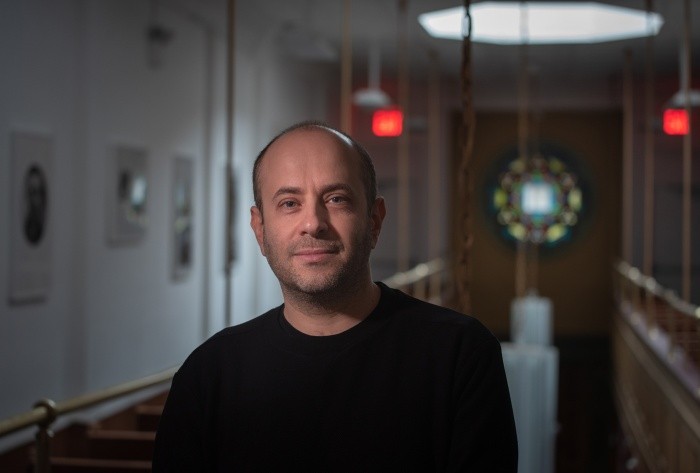In this feature, Asylum artist Yevgeniy Fiks discusses his project “Yiddish Cosmos” and how it represents a larger phenomenon he calls “Yiddish contemporary art”.
“Yiddish Cosmos” is on view at the Israeli Center for Digital Art in Holon through July 25, 2020, as part of the exhibition “Off to Space: Counternarrating the Cosmos”.
In “Off to Space: Counternarrating the Cosmos,” curator Maria Veits has brought together works by artists who engage with facts and fictions of space exploration, geopolitics, and power structures.
In addition to the exciting works by Black Quantum Futurism, Masha Godovannaya, Andréa Stanislav, Axel Straschnoy, and Driant Zeneli this group exhibition includes my project “Yiddish Cosmos.”
“Yiddish Cosmos” has been exhibited in New York, Paris, Moscow, Budapest, and now Holon. It explores real and imaginary connections between an invented language of interplanetary communication and the Yiddish language, all the while juxtaposing the Soviet space program’s imagery with Soviet Jewish community and Yiddish culture.

“Yiddish Cosmos” speculates on how the idea of Cosmos in the Soviet context would become the epitome of the Homeland for Soviet Jews as a diasporic people. If the 20th century Eastern European Jewish narrative is one of longing for universalism and scientific progress, it is Cosmos as a “homeland” that most perfectly embraces those dreams.
I see “Yiddish Cosmos” as a representative of a phenomenon that I’d like to call “Yiddish Contemporary Art.”
But what is Yiddish Contemporary Art?
While art forms that directly employ language—literature, music, and theater—naturally became primary forms of the new Yiddish culture, Yiddish contemporary (visual) art has yet to emerge. But what would constitute Yiddish contemporary (visual) art? Is it contemporary visual art that uses the Yiddish language in some form—text, letterforms, speech—that is, for instance, a video or sound installation or a performance art piece? To what extent and in what forms the Yiddish language must be present in an art piece to be considered Yiddish contemporary art? Perhaps “Yiddish contemporary art” must be defined in more open-ended terms?

I propose we consider “Yiddish contemporary (visual) art” as any contemporary art piece—contemporary painting, works on paper, installation, photography, video, sound, performance art, new media, social practice, etc.—that are consciously produced by the artist as a project of the new Yiddish culture. This art can either directly employ the Yiddish language, form, subjects, themes of Yiddish/Eastern European Jewish culture or be situated in less straightforward relation to them. Works of Yiddish contemporary art have an intentional and knowable connection to the language(s) and culture(s) of Eastern European Jewish communities, in dialogue to language(s) and culture(s) of their neighbors and the world at large.
The concept of “Yiddish Contemporary Art” as exemplified in my project “Yiddish Cosmos” is about attempting to reach the equilibrium between particularism and universalism. “Yiddish Cosmos” is migrant, diasporic, and global. It’s not about reviving or resuscitating the culture of the past but about continuing and reimagining Yiddish culture in earlier unforeseen forms under new conditions.

Images:
Yevgeniy Fiks, Yiddish Cosmos, 2017. “Off to Space: Counternarrating the Cosmos”. Curator: Maria Veits. Israeli Center for Digital Art, 2020. Installation view. Photo: Shir Comay


